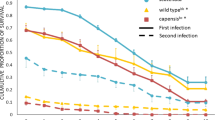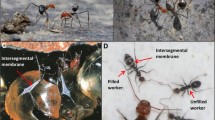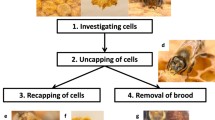Abstract.
Social parasitism is widespread in the eusocial insects. Although social parasites often show a reduced worker caste, unmated workers can also parasitize colonies. Cape honeybee workers, Apis mellifera capensis, can establish themselves as social parasites in host colonies of other honeybee subspecies. However, it is unknown whether social parasitism by laying workers also occurs among Cape honeybee colonies. In order to address this question we genotyped worker offspring of six queenless A. m. capensis colonies and determined the maternity of the reproducing workers. We found that three non-nestmate workers dominated reproduction in a host colony and produced 62.5% of the progeny. Our results show that social parasitism by laying workers is a naturally occurring part of the biology of Cape honeybees. However, such social parasitism is not frequently found (6.41% of the total worker offspring) probably due to co-evolutionary processes among A. m. capensis resulting in an equilibrium between selection for reproductive dominance in workers, colony maintenance and queen adaptation.
Similar content being viewed by others
Author information
Authors and Affiliations
Corresponding author
Additional information
Received 28 July 2005; revised 19 September and 11 November 2005; accepted 16 November 2005.
Rights and permissions
About this article
Cite this article
Härtel, S., Neumann, P., Raassen, F.S. et al. Social parasitism by Cape honeybee workers in colonies of their own subspecies (Apis mellifera capensis Esch.). Insect. Soc. 53, 183–193 (2006). https://doi.org/10.1007/s00040-005-0857-2
Issue Date:
DOI: https://doi.org/10.1007/s00040-005-0857-2




